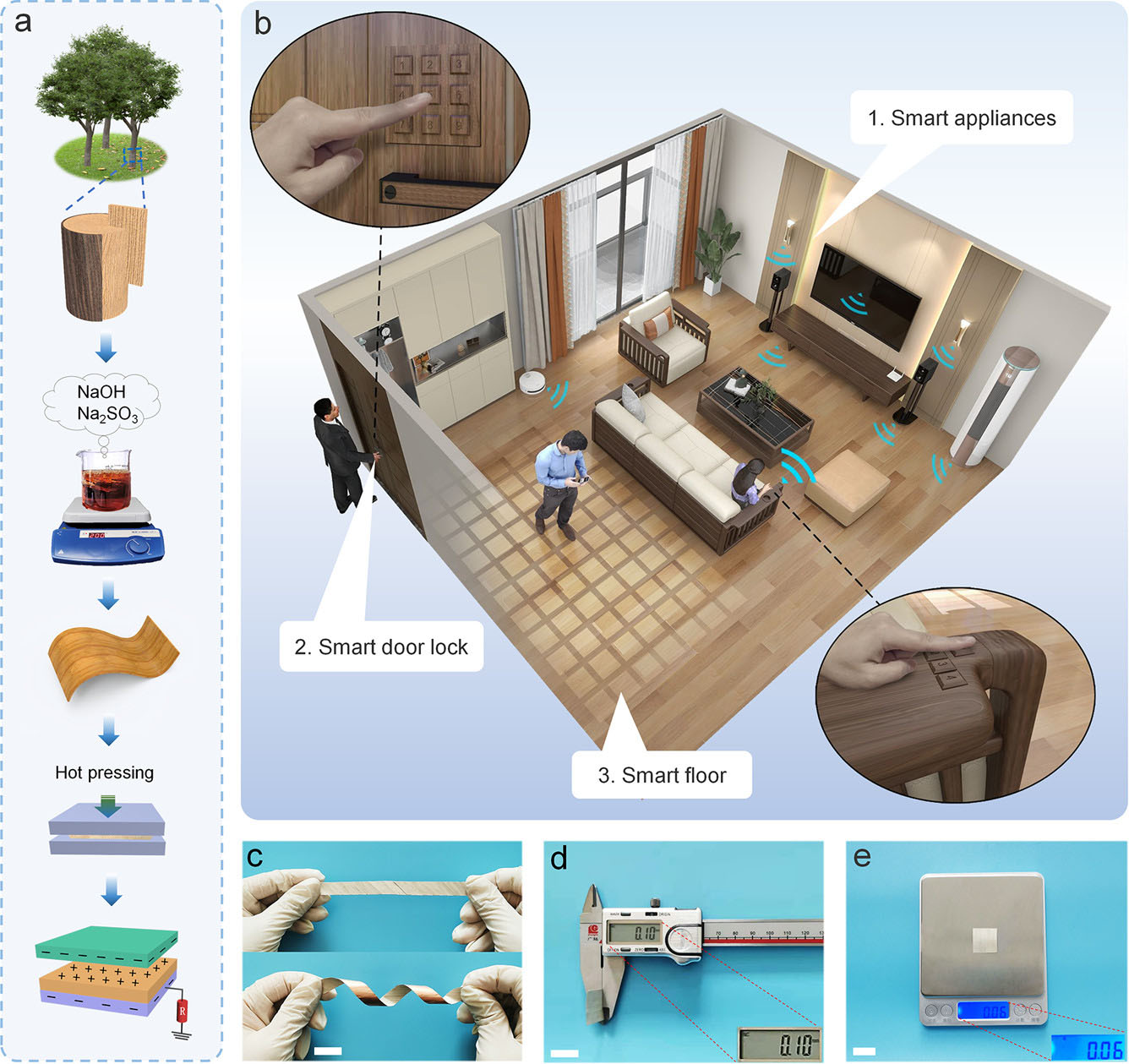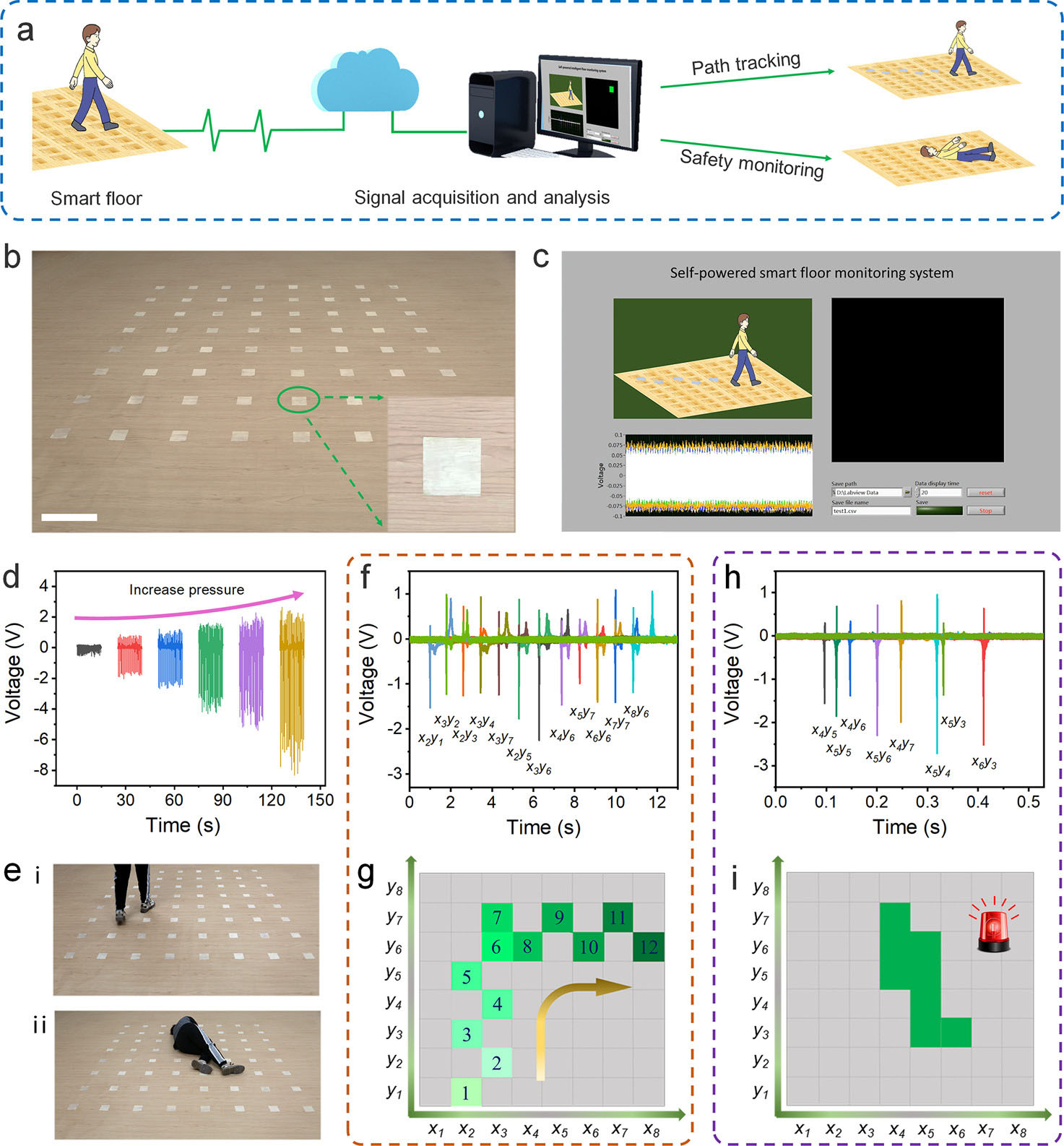| Feb 13, 2022 |
Wood-based self-powered smart home systems
(Nanowerk News) With the increased use of Internet of Things (IoT) devices and artificial intelligence, the technical development of smart home applications plays an increasingly important role in improving people's quality of life and health. The key component for setting up and running smart home systems are sensing devices – for light, temperature, motion, pressure, etc. – which are distributed across the home environment and function as the basis for all home control systems.
|
|
Traditional sensors face limitations due to their need for a power souce such as limited lifetime, high cost, and environmental pollution when using batteries. Therefore, finding a low-cost, long-term stable, and highly sensitive sensing technology is the key to lower the threshold of the popularization of smart homes.
|
|
To address this issue with a possible solution, researchers have developed a flexible wood-based triboelectric self-powered sensor to be used in smart home systems. As the team reports in ACS Nano ("Flexible Wood-Based Triboelectric Self-Powered Smart Home System"), by using an effective and simple processing method, the fabricated wood-based sensor has numerous advantages, including light weight, low thickness, high sensitivity, flexibility, and stability.
|
|
A schematic of the fabrication process of the flexible wood-based triboelectric self-powered sensor (WTSS) is shown in the figure below:
|
 |
| Figure 1. Schematic and fabrication of the wood-based triboelectric self-powered smart home system. (a) Diagram of the fabrication process for the WTSS. (b) Schematic illustration of the WTSS-enabled smart home system. Potential applications of WTSSs in household appliance control, a door lock, and flooring. (c−e) Photographs of the as-prepared WTSS, demonstrating its (c) flexibility, (d) thickness, and (e) weight. Scale bar: 2 cm. (Reprinted with permission by American Chemical Society)
|
|
First, natural balsa wood was converted into flexible wood by a two-step strategy involving chemical boiling in a mixed solution of NaOH and Na2SO3 followed by hotpressing. Then, the obtained flexible wood with a thickness of 0.1 mm was used for fabricating the triboelectric self-powered sensing device. The researchers point out that chemical treatment plays a vital role in the production of the WTSS.
|
|
The flexible wood sheets were cut into small sizes as the dielectric electrification layer. Then, a layer of copper film with the same size was pasted on the flexible wood as the electrode layer to fabricate the WTSS. Finally, a copper wire was attached to the copper film for electric connection.
|
|
The sensing mechanism of the WTSS is based on the coupling effect of contact electrification and electrostatic induction. The charge transfer occurs on the contact interface between a commercial PTFE film and the wood film during the process of approaching and pressure.
|
|
Size is a major factor to determine the output voltage as well as the sensitivity of the WTSS. For WTSSs with different sizes (side lengths from 1 to 5 cm), their output voltage is positively correlated with the object area, which is attributed to the friction charges induced by a larger contact area.
|
 |
| Figure 2. Application of the WTSS in the smart home control. Schematic diagram of the smart appliance control system. (Reprinted with permission by American Chemical Society)
|
|
The team developed a self-powered smart appliance control system by integrating their WTSS with home furniture, a simple signal control circuit, and some household appliances. As illustrated in Figure 2 above, while touching the WTSS integrated with the furniture, an obvious output signal will be generated. Through signal processing and wireless signal transmission, the household appliances can be remotely controlled.
|
|
Another application demonstrated by the authors is a smart floor monitoring system. Fabricating with wood materials, the WTSSs can be easily integrated with the wooden floor for realizing self-powered walking behavior and health monitoring. When people walk on the floor, output voltage signals corresponding to each touching position will be produced and collected via a multichannel data acquisition method. After signal processing and analysis, various functions, including gait characteristics recording, path tracking, and safety monitoring can be simultaneously realized.
|
 |
| Figure 3. Application of WTSS in the smart floor monitoring system. (a) Schematic diagram of the smart floor monitoring system. (b) Photograph of the WTSS-based smart floor. Scale: 20 cm. (c) Demonstration interface of the smart floor monitoring system. (d) Output voltage signals of the smart floor under different pressures. (e) Photographs of a tester walking (i) and falling on the smart floor (ii). (f) Output voltage signals of the tester walking on the smart floor. (g) Path display of the tester walking on the smart floor. (h) Output voltage signals of the tester falling on the smart floor. (i) Highlights and alarms in the sensing area of the smart floor monitoring system during a fall. (Reprinted with permission by American Chemical Society)
|
|
"Owing to its easy fabrication process and abundant material source, the WTSS can greatly improve the safety, convenience, and comfort of a living environment," the authors conclude their paper. "This research demonstrates the promising applications of the environmentally friendly WTSS in constructing smart homes and smart cities, which will bring a great opportunity in the development of sustainable society in the future."
|



 By
Michael
Berger
– Michael is author of three books by the Royal Society of Chemistry:
Nano-Society: Pushing the Boundaries of Technology,
Nanotechnology: The Future is Tiny, and
Nanoengineering: The Skills and Tools Making Technology Invisible
Copyright ©
Nanowerk LLC
By
Michael
Berger
– Michael is author of three books by the Royal Society of Chemistry:
Nano-Society: Pushing the Boundaries of Technology,
Nanotechnology: The Future is Tiny, and
Nanoengineering: The Skills and Tools Making Technology Invisible
Copyright ©
Nanowerk LLC
